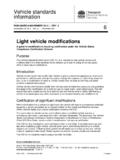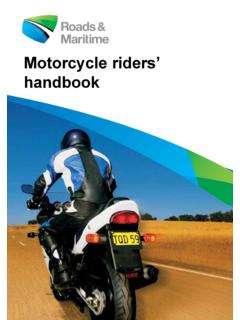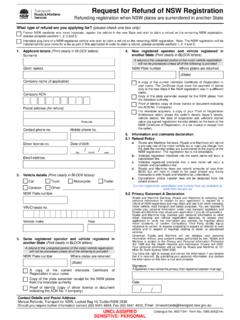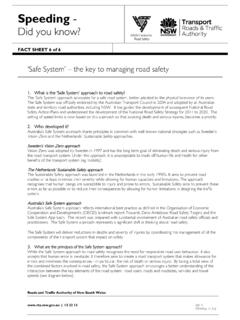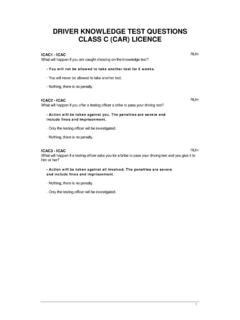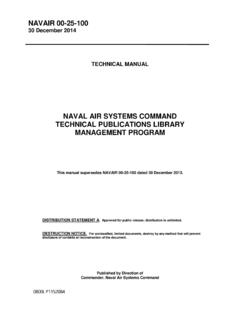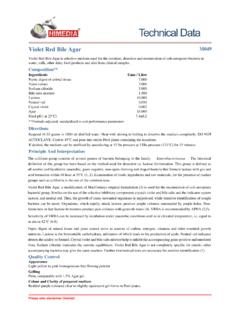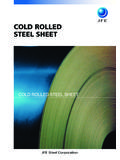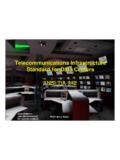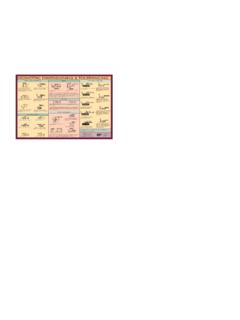Transcription of TECHNICAL GUIDE L-G-002 - Roads and Maritime Services
1 TECHNICAL GUIDE L-G-002 Field density testing by using a nuclear density gauge February 2015 TECHNICAL GUIDE | L-G-002 | February 2015 Field density testing by using a nuclear density gauge Printed copies of this document are uncontrolled RMS Page 2 |21 About this release Title: Field density testing by using a nuclear density gauge Author: Anthony Bretreger, External Laboratory Improvement Manager Authorised by: George Vorobieff, Principal Engineer, Pavements and Geotechnical, Engineering Services Branch Ed/Rev Number Date Revision description Ed 1/ Rev 0 February 2015 New Edition The most recent revision to this TECHNICAL GUIDE L-G-002 (other than minor editorial changes) is indicated by a vertical line in the margin as shown here. TECHNICAL GUIDE | L-G-002 | February 2015 Field density testing by using a nuclear density gauge Printed copies of this document are uncontrolled RMS Page 3 |21 Foreword and disclaimer This GUIDE has been prepared by Roads and Maritime Services , Engineering Services Branch.
2 This GUIDE is intended for use by Pavement practitioners who have satisfactorily completed appropriate training in pavement design. Persons or organisations ext ernal to Roads and Maritime Services considering use of the GUIDE should obtain independent expert advice applicable to their particular circumstances including advice as to the appropriateness of the GUIDE for use by them. The GUIDE has been written for use within the management structure of Roads and Maritime Services and references to responsibility for various actions are expressed in terms of that structure. Persons ext ernal to Roads and Maritime Services considering the use of the GUIDE should consider how those responsibilities would be addressed within their own management structures. No warranty or represent ation (expressed or implied) is made by Roads and Maritime Services , its employees or agents in relation to the accuracy, currency or adequacy of the GUIDE or that it is fit for purpose. Roads and Maritime Services accepts no responsibility whatsoever arising (whether by statute, in tort, contract or otherwise at law) out of or in connection with the contents or use of the GUIDE .
3 The GUIDE is copyright. Apart from any use as permitted under the Copyright Act 1968, no part may be reproduced by any proc ess without written permission from Roads and Maritime Services . TECHNICAL GUIDE | L-G-002 | February 2015 Field density testing by using a nuclear density gauge Printed copies of this document are uncontrolled RMS Page 4 |21 Contents Preface .. 5 1. Introduction .. 5 2. Definitions .. 6 3. Compaction and relative 6 4. Test methods .. 7 5. Lot testing .. 7 6. Test site 8 7. Nuclear density gauge .. 8 Safety .. 8 How does the NDG work? .. 9 Calibration and checks .. 10 Limitations .. 11 NDG 11 Using NDG to T173 .. 12 8. Trench testing .. 13 9. Moisture content 14 10. Sampling for laboratory based testing .. 15 11. Testing stabilised or bound material .. 16 12. NDG testing of asphalt .. 16 13. References .. 17 Annexure A Sample NDG Certificate .. 19 Annexure B Typical recording form for density counts.
4 21 TECHNICAL GUIDE | L-G-002 | February 2015 Field density testing by using a nuclear density gauge Printed copies of this document are uncontrolled RMS Page 5 |21 Field Density Testing by using a Nuclear Density Gauge Preface This GUIDE covers Test Methods T120, T121, T173 and T180. 1. Introduction Nuclear density gauges (NDG) are used to determine compaction acceptance of earthworks, granular and stabilised pavement materials and asphalt. This GUIDE provides staff undertaking general surveillanc e with guidance on the general aspects of field density testing as applied to earthworks and pavement materials placed and compacted for road applications in accordance with specifications and test methods. Compliance with the specified compaction and density requirements is a key acceptance criterion for earthworks and pavements specifications. Nuclear density gauges (see Figure 1) are often used for testing on earthworks for compaction acceptance and the NDG asphalt thin-layer gauge (see Figure 2) is used for asphalt materials.
5 Figure 1: The NDG is seated on reference block (Source: VicRoads TN106) Figure 2: The NDG Asphalt thin-layer gauge seated on reference plate (Source: VicRoads TN106) TECHNICAL GUIDE | L-G-002 | February 2015 Field density testing by using a nuclear density gauge Printed copies of this document are uncontrolled RMS Page 6 |21 W here surveillance of the field density testing reveals non-conformance, specialist surveillance personnel may need to review the detail of practices associated with the application of the test method, both in the field and in the laborat ory. This GUIDE is restricted to field density testing using the NDG, although other methods involving volume or sand replac ement methods can be used for field density testing. The laboratory testing and the preparation of test reports associat ed with these other field test are not discussed in this GUIDE . 2. Definitions The following list of definitions is used in this GUIDE and does not represent a complete list of soil testing definitions.
6 Backscatter mode - The retractable rod with the source is lowered so that it is even with the detector but still within the instrument. The source emits radiation, which then interact with electrons in the material and lose energy and/or are redirected (scattered). Radiation that is scattered towards the detector is counted. The denser the material, the higher the probability that radiation will be redirected towards the detector. Therefore, the detector count is proportional to the density. Backscatter mode is not used for testing compacted pavement construction materials Direct transmission mode - A test in which the Gamma source is placed into the material by means of a punched or drilled access hole. Gamma rays are transmitted from the sourc e, through the material to be measured, to the det ectors locat ed on the surface. The average density and moisture content of the lift of material are det ermined. Direct transmission mode is used for testing compacted pavement construction materials.
7 Dry density Mass of dry soil after drying at 105 C to 110 C, contained in the unit volume of undried soil Field density - The density of earthworks or pavement material measured insitu. NDG - Nuclear Density Gauge Proof rolling Subjectively assessed deformation test where the transient surface deformation under specified loading equipment is perceptible or not. Perceptible deformation may be visible or elastic deformation (springing, spongy or resilient.) Relative compaction - The percentage ratio between the field density of a soil to the maximum density as determined by standard or modified compaction. Wet density Mass bulk soil, including solid particles, water and air contained in a unit volume. Lot - A lot is based on no more than one day s production and must only contain an area of work that is defined as a single layer, batch or area of like work which has been constructed or produced under essentially uniform conditions and is essentially homogeneous with respect to material and appearance (refer to specification Q6, Annexure Q/L).
8 3. Compaction and relative compaction Road making techniques need to achieve adequate compaction of plac ed material during construction to prevent in-service problems, such as densification, settlement, rutting etc and to inhibit movement of water in and out of the material. The level of compaction is commonly referred in specifications as the relative compaction and expressed as a percent age. It is commonly determined by field density testing using a NDG and laboratory-based reference density testing on samples of the material. TECHNICAL GUIDE | L-G-002 | February 2015 Field density testing by using a nuclear density gauge Printed copies of this document are uncontrolled RMS Page 7 |21 The key density testing requirements for the assessment of field compaction are: field density measurements by NDG sampling of material for laboratory-based testing laboratory testing using calibrated apparatus to obtain the reference density and production of results and test reports.
9 Compaction assessment of road making materials is based on the characteristic value as determined in T166 using a number of test sites per lot (refer to specification Q6, L3). The acceptance limits for different road making materials are det ailed in the relevant specifications. Proof rolling is used in earthworks and pavement construction to verify both uniform behaviour and stability of the layer before the next layer is placed and compacted. Proof rolling is complimentary to assessment of compaction by field density testing. For more information about proof rolling refer to T198. 4. Test methods The Roads and Maritime permits the use of the nuclear density gauge for the determination of field density. Reference density measurements using laboratory compaction methods, with standard or modified compaction effort, are carried out on material sampled from the site. The test methods are det ailed in Roads and Maritime and Australian Standard test methods, with specific application requirements detailed in the relevant specifications, ( R44, R71, etc).
10 Laborat ories carrying out the testing must be accredited for each test that is involved by the National Association of Testing Laborat ories, Australia (NATA). The acceptance of work using density and compaction criteria is based on the test being performed in accordance with the relevant test methods. 5. Lot testing Road making materials for earthworks and pavements are tested in lots for acceptance. A lot is based on no more than one day s production and must only contain an area of work that is defined as a single layer, batch or area of like work which has been constructed or produced under essentially uniform conditions and is essentially homogeneous with respect to material and appearance (refer to specification Q6, Annexure Q/L). For example, a test lot for earthworks and pavement materials may be broadly defined as those areas of work that are subst antially alike for: material properties and sourc e general appearance (for example, colour; surface texture) moisture condition during compaction compaction technique, including number of roller passes layer thickness, and state of underlying materials.



